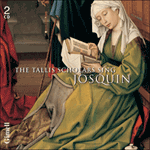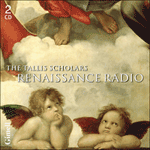
Welcome to Hyperion Records, a British classical label devoted to presenting high-quality recordings of music of all styles and from all periods from the twelfth century to the twenty-first.
Hyperion offers both CDs, and downloads in a number of formats. The site is also available in several languages.
Please use the dropdown buttons to set your preferred options, or use the checkbox to accept the defaults.

The remainder of the setting seems more relaxed though, in fact, Josquin can be heard to be constantly trying out new speeds, new rhythms and new scorings for the L’homme armé tune, now complete, now with a few notes used as the basis for an ostinato pattern or a canon. The wide overall range of the four voice-parts brings to the writing the kind of sonority which is associated with Palestrina, and Josquin constantly uses this to imaginative effect, nowhere more memorably than at ‘Et resurrexit’ in the Credo. For showing all these different aspects of his extraordinary technique, this Mass must rank as one of the most accomplished productions of a composer long held to be the greatest writer of his time.
from notes by Peter Phillips © 1989
Le reste de l’oeuvre semble plus détendu, bien que l’on remarque en fait que Josquin essaie constamment de nouvelles allures, de nouveaux rythmes et de nouveaux arrangements pour l’air de L’homme armé, tantôt complet, tantôt réduit à quelques notes servant de base à un motif obstiné ou à un canon. L’étendue du registre des quatre parties vocales donne à l’écriture le type de sonorité qui est associée à Palestrina. Josquin y eut constamment recours dans un sens imaginatif, et il ne le fit jamais mieux que sur «Et resurrexit» dans le Credo. Parce qu’elle révèle tous ces aspects différents de son extraordinaire technique, cette Messe doit compter parmi les oeuvres les plus accomplies d’un compositeur qui fut longtemps considéré comme le plus grand de son époque.
extrait des notes rédigées par Peter Phillips © 1989
Français: Meena Wallaby
Die übrige Vertonung macht einen entspannteren Eindruck, auch wenn man ständig Josquins Versuche heraushören kann, neue Tempi, neue Rhythmen und neue Besetzungen auf die L’homme-armé-Melodie anzuwenden, mal vollständig, mal mit einigen wenigen Tönen als Grundlage für ein Ostinatoschema oder einen Kanon. Die insgesamt weite Spanne der vier Gesangsstimmen verleiht dem Satz jene Klanglichkeit, die man mit Palestrina verbindet, und Josquin macht davon immer wieder einfallsreich Gebrauch – besonders einprägsam bei „Et resurrexit“ im Credo. Dadurch, daß er die diversen Aspekte seiner außerordentlichen Kompositionstechnik aufzeigt, muß diese Messe zu den vollendetsten Werke eines Komponisten gerechnet werden, der seit langem als der bedeutendste Tondichter seiner Epoche gilt.
aus dem Begleittext von Peter Phillips © 1989
Deutsch: Anne Steeb/Bernd Müller
Il resto dell’intonazione appare meno elaborato. Tuttavia, si sente che Josquin sperimenta costantemente nuovi impulsi motorii, nuovi schemi ritmici e nuovi impasti timbrici per la melodia de L’homme armé, che talvolta vien presentata completa, talaltra con alcune note, usate come base per un ostinato o un canone. L’estensione nel complesso ampia delle 4 v. porta il musicista a realizzare un tipo di sonorità, che è messa in relazione con Palestrina e che nel nostro caso è impiegata regolarmente per ottenere effetti immaginosi, soprattutto in passi memorabili come nell’“Et resurrexit” del Credo. Poiché questo lavoro è l’esemplificazione dei diversi aspetti della straordinaria tecnica josquiniana, esso si colloca tra le creazioni più raffinate dell’artista, considerato a lungo come il più grande compositore del suo tempo.
Peter Phillips © 1989
Italiano: Bruno Meini
 Josquin: The Tallis Scholars sing Josquin Josquin: The Tallis Scholars sing Josquin"If one were looking for a superstar among Renaissance composers then Josquin is unquestionably the front runner. He was a star in his lifetime and he has become a star again more recently, aided in part when the recording of the two Masses on the ...» More |
 Renaissance Radio Renaissance RadioSacred Music from the Renaissance Era for Celestial and Secular Radio. When Peter Phillips founded The Tallis Scholars in 1973 sacred vocal music from the Renaissance Era was seldom heard on radio. Now it is firmly established as one of the great ...» More |

